Rapidly changing markets and technologies are forcing a shift from monolithic to microservices architecture. Compared to monolithic architecture, services-based MACH allows you to update separate modules in your ecommerce marketplace. Thus, you do not have to redo the whole system.
Whenever you need changes based on customer feedback or make updates, you can fix a separate service. The rest of your MACH marketplace will be working as usual at that time.
However, there is a twist in this story. Transitioning from a monolithic structure to MACH requires a thorough plan, strategy, resources, and alignment of all teams involved in the transition process. So, the move will be feasible for businesses that are big enough or plan to grow and want to avoid the ceiling with coupled elements in their codebase.
This guide is an overview of how basic processes happen in the transition from a monolithic design to MACH. Our experts have helped businesses to migrate their marketplaces and share their experiences in this concise guide. We cover the basic steps and best practices for this move of an ecommerce marketplace platform. Read on to learn more details.
Overview of monolithic architecture in ecommerce
Monolithic architecture has been a trusted foundation in system design for years. Its straightforward approach allows the entire platform to operate smoothly as a unified system based on a single, cohesive code base.
In monolithic solutions, components are tightly coupled and directly connected to each other. So, product catalog management, customer accounts, payment processing, order management, and inventory tracking are built as one system in a marketplace.
Let’s understand it through an analogy. For example, take a building. Though it has multiple stories and is built of different components, it is a unit on top of one foundation. In the same way, the monolithic architecture of an ecommerce or any other monolithic digital solution uses a single code core.
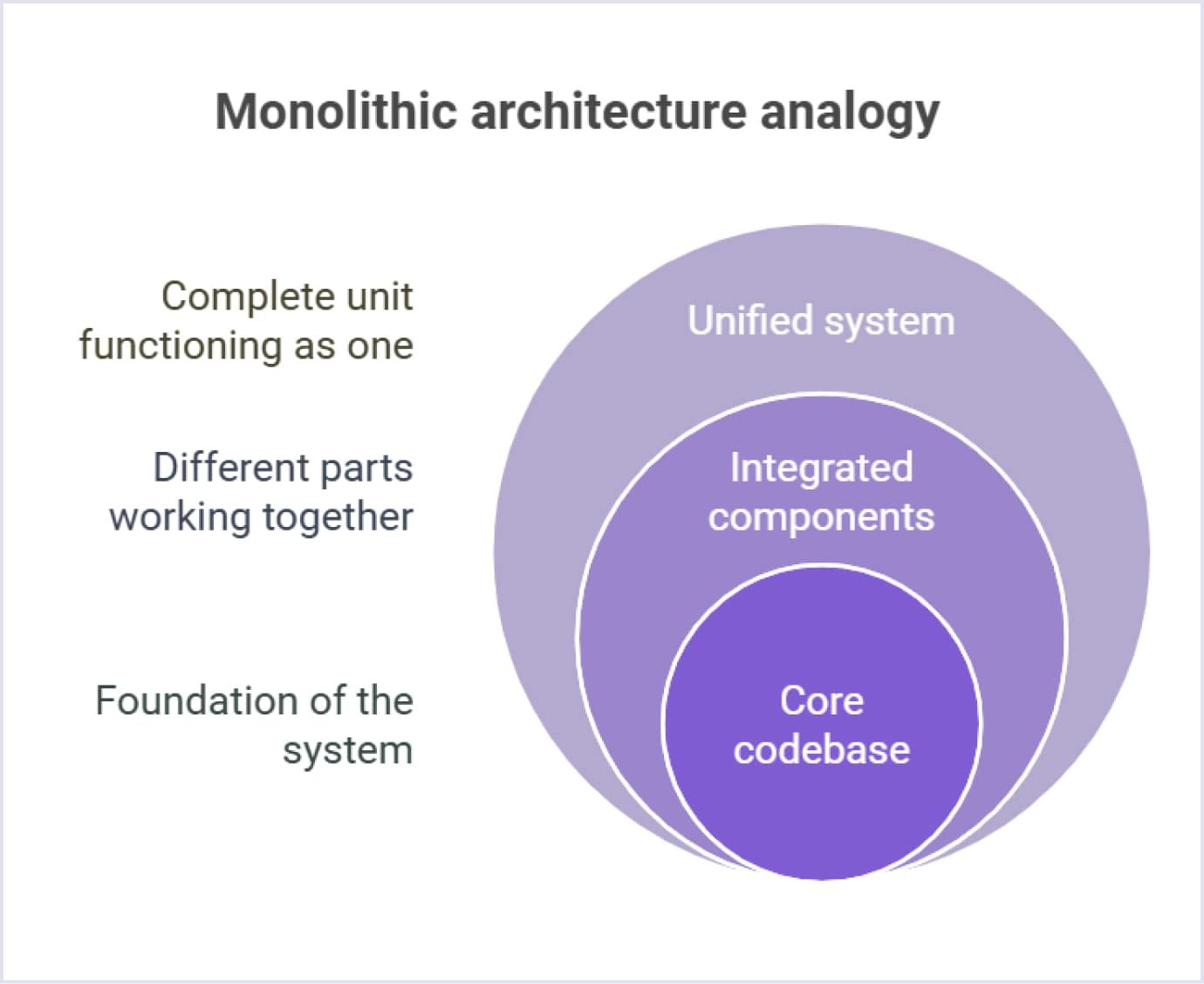
The monolithic architecture ensures fast development and deployment since you do not have to manage separate components. It is a cost-effective approach for small projects.
While it is handy initially, you may face challenges with a monolithic structure when updating and scaling your ecommerce marketplace later. Let’s cover them in more detail.
Limitations of monolithic architecture in modern ecommerce
While monolithic architecture provides benefits at the early stages of development or for small projects, it has several shortcomings for bigger codebases. Being a whole of interdependent components, a monolithic solution lacks agility. From this, the following monolithic systems limitations stem:
- Scalability challenges. Monolithic systems are complex to scale as their components are tightly coupled. If one feature experiences high demand, the entire application must be scaled, or it will not handle the load. This inflexibility is the point why the solution’s resources are used inefficiently, and costs get higher over time;
- Lack of flexibility. Making changes or introducing new features in a monolithic structure can be time-consuming. Even if you have minor updates, developers must test and redeploy the entire system. So, your platform’s updating and time-to-market slow down;
- Reliability issues. With a monolithic solution, if one component fails, the whole system is affected. For instance, if your payment processing module fails, the entire marketplace may become unresponsive. So, you may lose your customers’ engagement and loyalty;
- Maintenance complexity. As your platform grows, the codebase becomes more complex and more demanding to manage. If you need to fix bugs or update features, you or your tech vendor should know the entire code. Thus, development extends and requires more resources;
- Technology lock-in. Monolithic solutions often rely on a single technology stack and impede legacy system modernization. Thus, it is challenging to adopt modern tools or frameworks without overhauling the entire system.
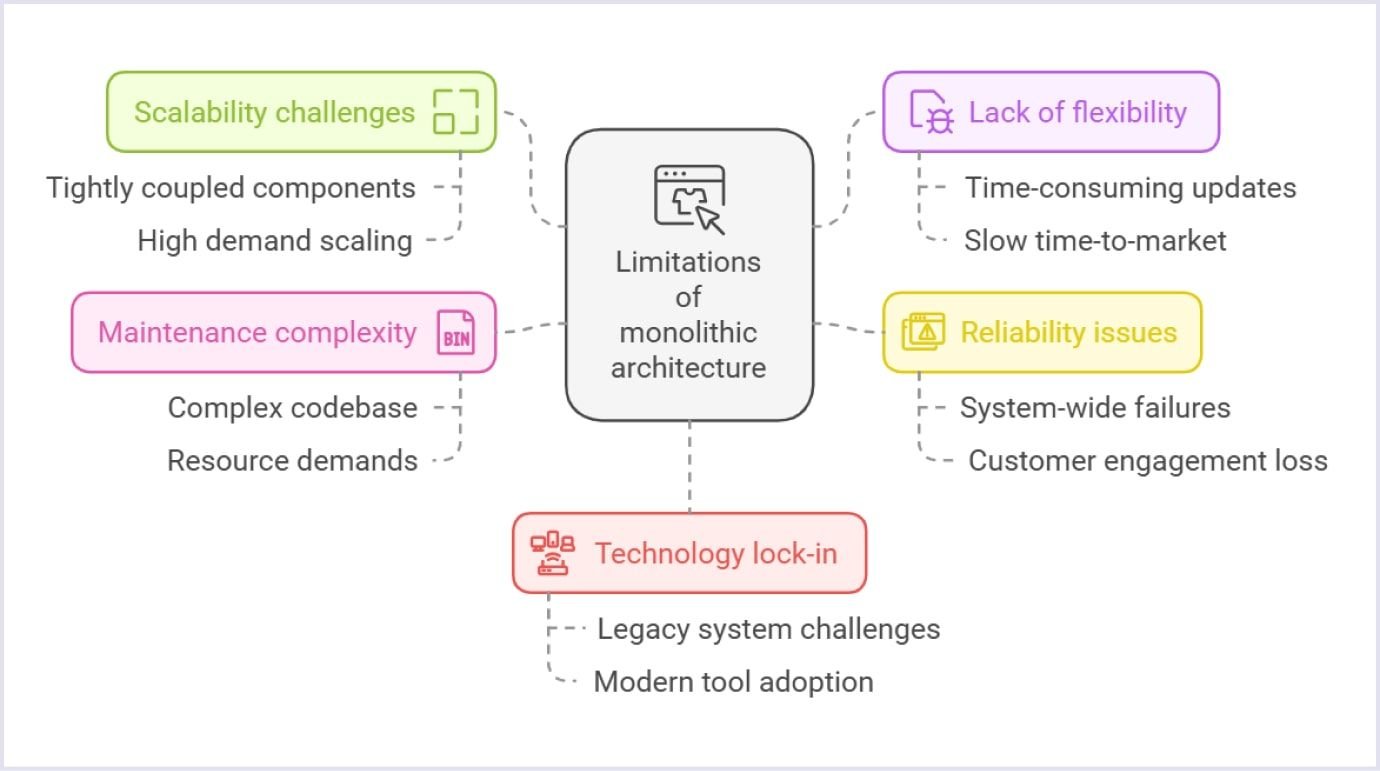
Benefits of MACH architecture for ecommerce marketplaces
The MACH architecture, unlike the monolithic one, uses independent yet connected components. They are based on Microservices, APIs, Cloud-native nature, and Headless architecture. Hence, the abbreviation. This modular structure of your ecommerce platform provides a number of benefits:
- Scalability. Thanks to component independence and cloud-nativity, you can ensure ecommerce platform scalability as needed. Thus, you ensure optimal performance during peak traffic, such as Black Friday or holiday sales. At the same time, you gain optimized resource consumption.
- Microservices flexibility. Microservices allow you to build, test, and deploy marketplace features independently. Since you build the marketplace features as autonomous modules, you simplify and accelerate development and updates for each feature or API. Moreover, you reduce system failure risks when adding or improving functionality.
- Omnichannel customer experience. The frontend and backend are separated via headless architecture in MACH. Therefore, if you make changes to data at one touchpoint interface, the changes are consistent and reflected across all other touchpoints and devices, including web, mobile, and IoT.
- Faster time-to-market. The MACH architecture's API-first development facilitates the integration of your platform with other tools and services. As a result, you can include new features and technologies without affecting the whole system and deliver them to market faster.
- Saving costs. As MACH solutions run in the cloud, you can use the pay-as-you-go model. You can pay only for those resources that you use and save infrastructure expenses.
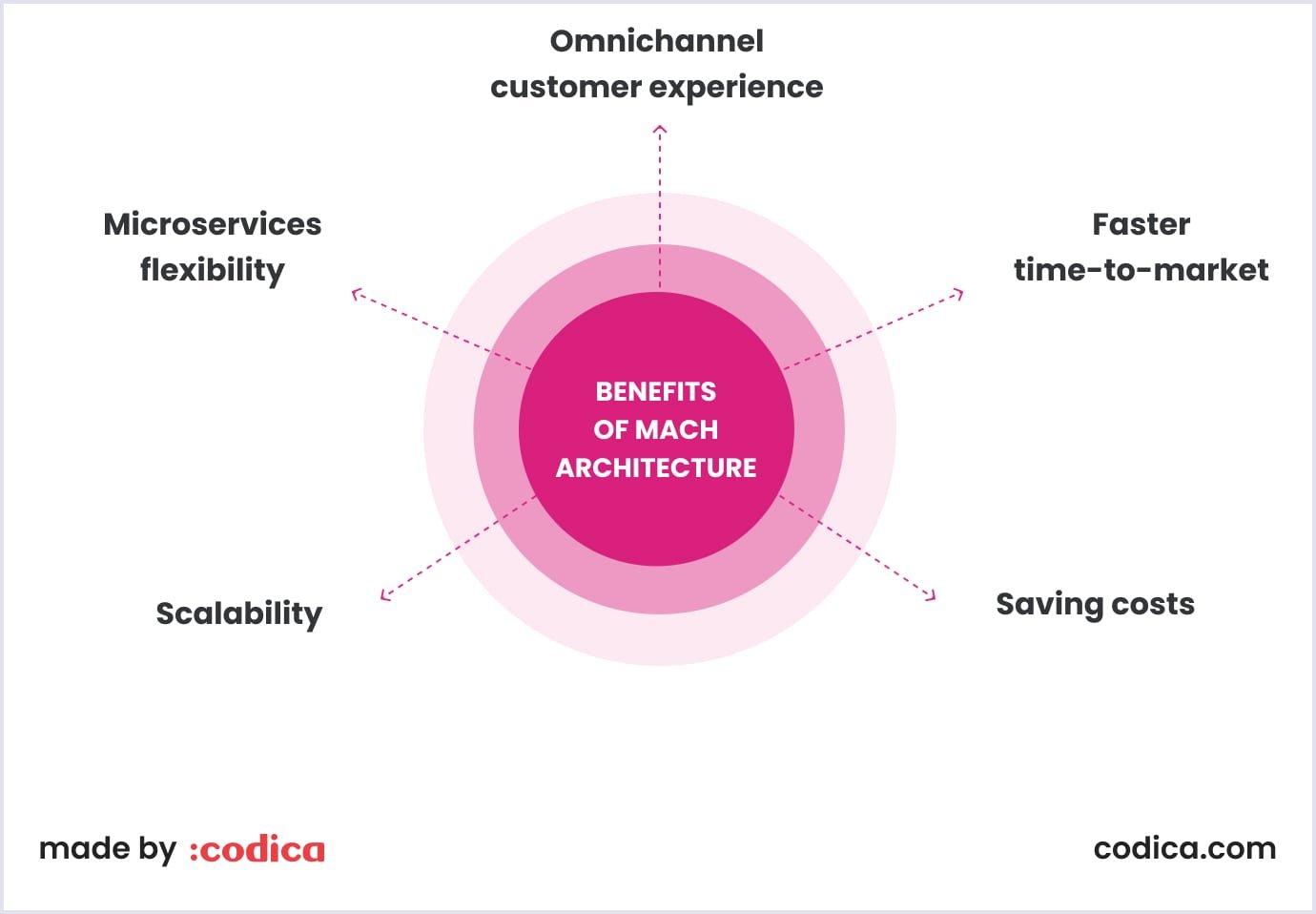
For example, eBay started with a monolithic design. However, in 2000, as the platform evolved, the company understood the necessity of moving to composable commerce.
There was no MACH term at that time, which was coined in 2018 by Commercetools. Still, the understanding of modular design benefits already appeared. Today, the MACH architecture is used for any platform that wants growth, agility, and scalability.
Now, let’s discuss the steps to move your ecommerce marketplace from being monolithic to becoming MACH.
Steps to transition from monolithic to MACH architecture
When you move from a monolithic to a service-based design, you need several phases. They require thorough preparation and planning. We describe the MACH transition strategies below to help you grasp what you need in this transition.
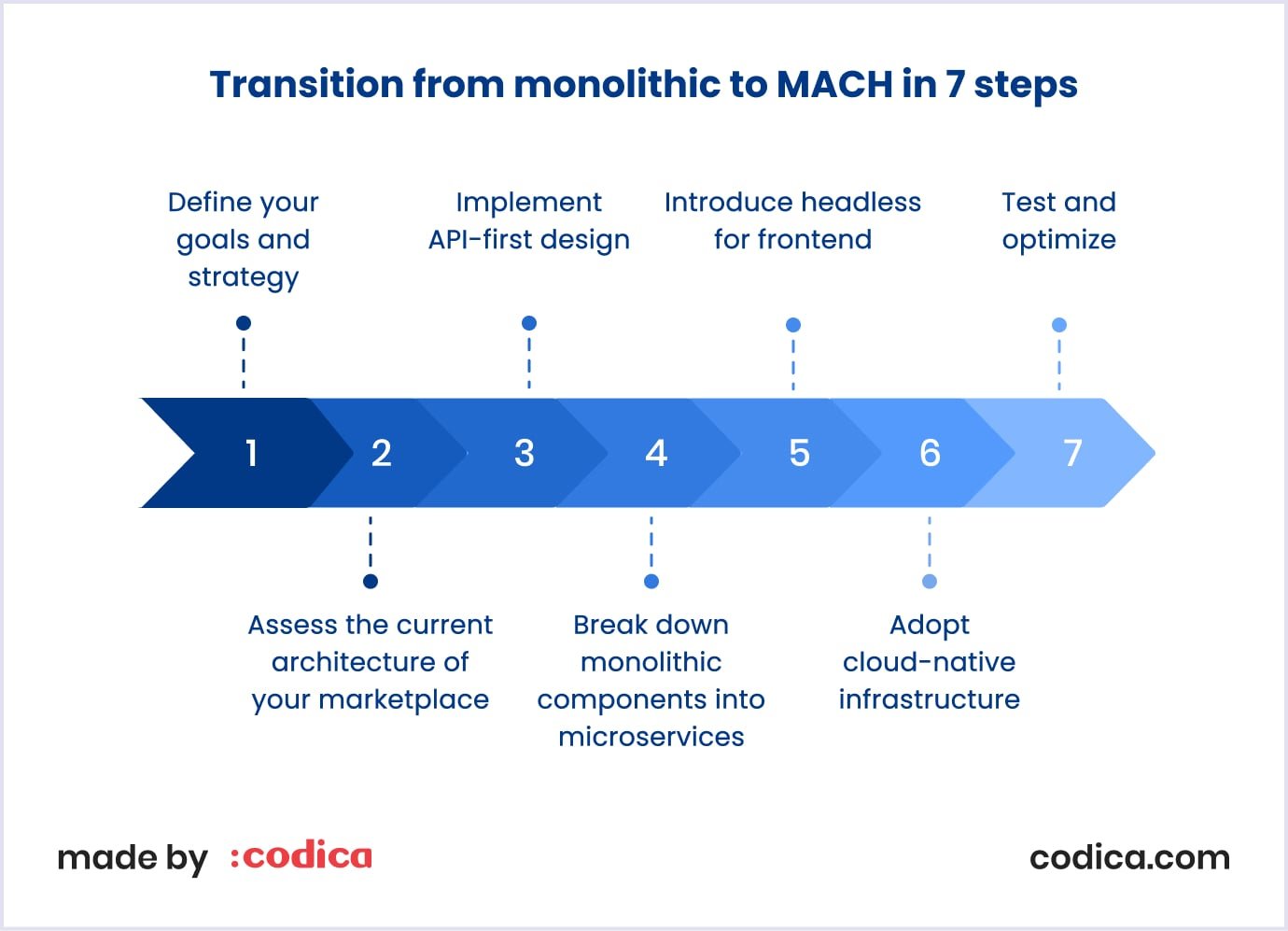
Step 1. Define your goals and strategy
Start by setting clear objectives for moving to MACH architecture. Common goals for ecommerce marketplaces include the following:
- Agility and scalability for competitive advantage;
- Faster time-to-market for features;
- Enhanced customer experience through a headless solution.
We recommend you discuss these goals with your team and tech partner. So, you will ensure that you have a well-planned strategy and gain the expected outcomes.
Step 2. Assess the current architecture of your marketplace
Before moving the parts, evaluate which features you need to transfer to the MACH ecommerce architecture. This step involves the following:
- Assessing which tightly coupled components need decoupling;
- Detecting features or services with scalability and performance bottlenecks;
- Your team’s readiness for building a MACH ecommerce solution;
- Availability of the relevant tech stack and resources.
Step 3. Implement API-first development
APIs ensure smooth communication between services and the frontend within your MACH marketplace. When considering API-first integration, take the following considerations into account:
- Identify microservices that will communicate with each other via APIs;
- Define requirements for APIs so you know which data connection they ensure within your solution;
- Design APIs before building services. Focus on designing APIs upfront to ensure they are robust, scalable, and easy to integrate;
- Each service should have its own API, making it independently deployable and scalable;
- Ensure your APIs are secure and built following the best industry practices.
Step 4. Break down monolithic components into microservices
Here is where you start reshaping your ecommerce platform’s backend. At this step, determine which specific features in your monolithic solution can be split into separate services. As the case may be, you may identify your product catalogs, payment processing, and user management. The count goes on depending on your solution’s complexity.
Gradually separate these components into independent microservices. This ensures their autonomous operation. Start with the components essential to your business or with the most significant scalability issues.
Step 5. Introduce headless architecture for frontend
Headless commerce, as it is put in the case of ecommerce marketplaces, also adds to the modularity of MACH solutions. Such an architecture means frontend-backend decoupling. In this case, you develop your representation layer (the frontend) independently of the business logic and data (the backend). For this, you can use the following tools:
- Frontend frameworks, such as React, Vue.js, and Angular;
- Headless CMS (content management system) like Strapi, Contentful, or Sanity;
- Static site generators like Gatsby or Next.js.
When introducing a headless frontend, ensure it is consistently displayed on the web, mobile, and IoT devices. Also, you can connect third-party services to your headless frontend via APIs. Thus, you will get swift payment updates, shipping tracking, and other data retrieval for a better user experience.
Step 6. Adopt cloud-native infrastructure
Select a reliable cloud service provider supporting microservices and robust tools for APIs and headless systems. Popular cloud-native SaaS platforms include Amazon Web Services, Google Cloud, and Azure. At Codica, we recommend AWS for cloud-native applications as it provides modern and versatile tools for solutions of any complexity.
When adapting microservices for the cloud, containerization is helpful. This means packing each microservice in a container and deploying it in the cloud. We recommend Docker for containerization and Kubernetes for orchestration, which handles containerized microservices in the cloud.

Step 7. Test and optimize continuously
Once you finish the migration, your ecommerce platform needs testing before going live. So, we recommend you take the following measures in quality assurance services for your solution:
- Test services separately and as a whole. For this, you can use unit testing, integration testing, and service virtualization;
- Check that APIs and microservices are connected seamlessly. Also, check that APIs can handle high traffic;
- Ensure that the user journey works at all points as intended, with the simulation of real-world scenarios;
- Implement alerts if scaling in the cloud faces issues;
- Check the frontend performance to measure load times and visual stability;
- Ensure scalability and security on your MACH platform by implementing the latest best practices.
Challenges in transitioning to MACH architecture
You win with MACH architecture in the long run. Still, you should know the common challenges businesses face when transitioning from a monolithic ecommerce marketplace to MACH architecture. They are as follows:
- Complexity in migration. The migration to MACH architecture means separating the tightly coupled components. It requires careful planning and takes time and resources, especially for large marketplaces and enterprise ecommerce platforms.
- High upfront costs. While MACH architecture brings long-term benefits, the transition requires significant initial investments. For transition, you need cloud infrastructure, modern development tools, and a skilled team familiar with the MACH approach. Upskilling existing teams or hiring new talent can be a challenge.
- Integration complexity. Decoupling and reintegrating components brings tangible results yet requires time and skill to connect all elements smoothly. Your team needs time and resources to ensure seamless work of microservices, APIs, and third-party integrations.
- Adopting agile workflow. Teams working on MACH migration win from modern agile methodologies and DevOps services. Thus, businesses win from teams that invest in modern workflow processes that help manage tasks in developing modular designs.
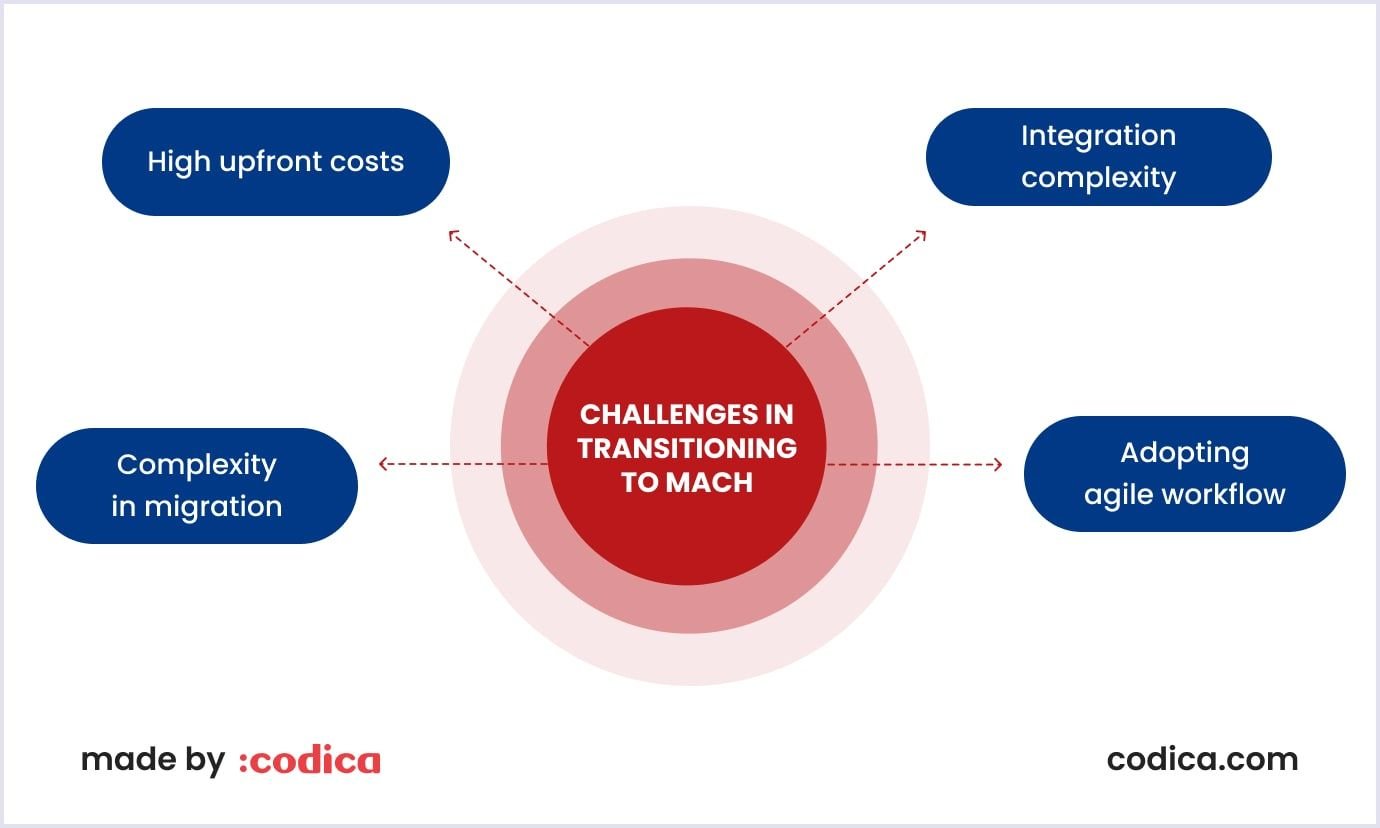
Best practices for a successful transition
Though transitioning to MACH is a versatile and multi-layer process, there are several aspects you can consider to make it easier. Here they are:
1. Start small
Begin with a small piece to test the waters. Select a non-critical component to transition first. For example, you can begin with search functionality or user reviews.
Starting small is crucial to minimize risks during replatforming ecommerce systems. It also helps your team to learn from the process and move toward the more complex components gradually.
For this, break down the chosen component into microservices, add APIs, and test scalability and performance. Once the component’s work is successful, gradually expand the transition to other components.
2. Collaborate across teams
When working on the transition, ensure that all teams have open and smooth communication on the processes. Development, project management, and business units should be on the same page and coordinate actions for optimized implementation.
Thus, using agile development in ecommerce with regular meetings on progress and challenges is feasible. Also, involving DevOps practices will help you optimize the transition and meet your budget expectations.
3. Prioritize security
Since ecommerce marketplace platforms store and process sensitive data, security is a top priority. Indeed, the attack surface increases with more moving parts in MACH solutions. The good news is that you can set how data is accessed and flows in your MACH marketplace. What’s more, if one microservice is compromised in terms of security, the rest of the platform will work as intended.
Which practices can you use for your MACH marketplace? They are as follows:
- Ensure API security with authentication methods like OAuth 2.0 and API keys;
- Secure data in transit and at rest with proper encryption in compliance with AES-256 and PCI SSD;
- Implement role-based access control (RBAC) and multi-factor authentication (MFA);
- Use security features of cloud providers;
- Ensure the security of container environments with regular monitoring, updating, and patching;
- Have an incident response plan in place for managing breaches or attacks;
- Ensure compliance with global security and data protection standards such as GDPR, HIPAA, and CCPA to avoid system and legal risks.

Future-proofing your ecommerce marketplace with MACH
Monolithic architecture has long been a go-to approach for software design, including ecommerce marketplaces. Yet, it is now feasible to use a more flexible decoupled architecture, like MACH. Though the transition from a monolithic architecture to MACH poses additional costs, in the long run, you win from this move.
What do you gain from the transition? Here are some points:
- Scalability for growing demands and high traffic;
- Flexibility in adding new features and updates;
- Agility in integrating APIs and third-party tools for enhanced functionality;
- Consistent user experience in omnichannel ecommerce solutions;
- Independence in components for stable platform operation;
- Enhanced security thanks to modern practices;
- Cost-effectiveness and resource optimization thanks to cloud nativity;
- Compatibility with future technologies.
It’s true that the transition requires careful planning, strategy, training, and the process itself. If you plan for your ecommerce marketplace to evolve, then this transition is what you need.
Codica’s experience in building MACH marketplaces
Our team is well-versed and experienced in modern technologies and development practices. After 9 years of successful development, we know that building solutions with future needs in mind is essential for businesses to grow. That is why, when it comes to new projects for ecommerce marketplaces, we build them based on the MACH approach.
For example, this is the case for migrating and renovating an online firearm store. Detroit Ammo Co. is the first multi-vendor marketplace where licensed vendors can sell firearms and ammunition. The company needed a robust custom solution since it operates under strict US law compliance. As the company accumulated a significant user base, we also had to preserve it in the new version of the platform.
Thanks to our team’s and client’s collaboration, we provided a flexible, secure, and compliant solution. Starting from project discovery, we defined the aspects to ensure the migrating and development process goes smoothly. Thus, we introduced storefront customization and improved the load time, search, filters, and site navigation, which led to a superior user experience.
Since the sales must be FFL compliant, we introduced a well-thought-out checkout system that verifies users’ eligibility to buy firearms and ammunition. Our team also created separate functionality for wholesalers and subscriptions for recurring orders.

Thanks to the modular architecture, we ensured that the platform would perform even at high load times, allow for easy updates, and provide security to users.
Check out our portfolio for more successful marketplaces and projects.
To wrap up
The transition from a monolithic to MACH architecture is a comprehensive process in ecommerce marketplaces. It requires meticulous planning, a well-thought-out strategy, and a trained team to implement the whole process. Yet, in the long run, you get a platform that can be adapted to tech and market changes and delight your customers.
If you decide to build a marketplace with MACH architecture and need guidance and support on the digital transformation in retail, we would be happy to help you. Contact us to discuss your project details and get a free quote.
